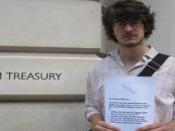Question on Capital Gains Tax Due Week 11:
Effect of death: s 128:
Death is generally not a CGT event (s 128). There is an exception under CGT event K3 s 104-215 that covers leaving assets to exempt entities as defined in s 995-1. In this case, Grundnorm's uncle died and left him a property consisting of a house and 10 hectares of land and some collectables and a yacht. There was no evidence to show that Grundnorm was a tax-exempt entity, therefore, CGT event K3 did not apply here.
General concepts to test whether there is a capital gain:
1) Whether it is a CGT asset:
According to s 108-5(1) of ITAA 1997, the land and the house are "any kind of property" and thus they are CGT assets. In addition, the solid gold Rolex watch and the pair of earrings are collectables. The yacht is a personal use asset.
They are all CGT assets.
2) The acquisition date of the assets:
In order for the current CGT provisions to apply it is necessary for the asset to have been acquired and disposed of after 19 September 1985. The taxpayer acquires a CGT asset when they first become the owner of the asset. (s 109-5(1)). In s 109-5(2), there is a table that shows the acquisition dates. Grundnorm acquired the property, watch, earrings and yacht in 1 July 1992, which was the date that his uncle Fred died. Thus, the assets are subject to CGT regime.
3) Whether any exemptions apply to the transaction or assets:
Once the assets are identified, it is necessary to consider whether the asset is exempt from the operation of the CGT provision. According to s 118-10, capital gains made on some personal assets and some collectables are ignored. The capital gain from a...


